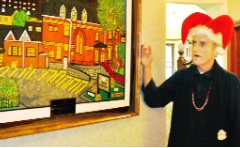
St. James Town resident and artist George MacIntyre.
Dennis Hanagan —
When he thought he was dying George MacIntyre didn’t sink into depression. Instead, he was inspired to get back to his artwork and make paintings as a legacy for people who died from, or are living with, HIV/AIDS.
Diagnosed with the disease in 1982 the St. James Town resident is still among us with the help of today’s powerful medicines. His acrylic paintings of buildings in his neighbourhood and in the Church-Wellesley Village present a distinct style with vivid colours and intricate detail.
In November, just one day before World AIDS Day, MacIntyre spoke to The Bulletin about his ordeals and triumphs with the disease and how his art has given him purpose in life. “There were times I didn’t know where (my art) was going to go, but I kept going,” said MacIntyre.
Next March he’s holding a grand opening for what will be his own little art gallery on the top floor of the community centre at 519 Church St. “It’s a legacy and respect for what the city of Toronto has of history in the gay community … and the people who worked hard to make that possible,” MacIntyre said.
He enjoyed making art as a small boy on Prince Edward Island where he grew up. His sister and mother encouraged him. His mom hooked rugs as she followed the patterns that MacIntyre drew for her. He drew Christmas cards and dropped them off at friends’ houses.
MacIntyre came to Toronto in 1980. He’s had four commissions to paint pictures of buildings, three of them Cabbagetown houses. Another hangs in an art gallery on McGill.
He spent time as a client at Casey House, Canada’s first HIV/AIDS hospice on Huntley St. He was asked to make a painting of the house and then he made another of the AIDS memorial in the parkette beside 519 Church.
“I didn’t plan on doing anything after that,” said MacIntyre, “but then after feeling the rhythm of dancing (creating art) I wanted to keep dancing.”
His art began appearing in Village buildings. “I didn’t have a dream in the world I was going to have a private room for my paintings. I’m very moved that I had a chance to express myself in art. It’s very colourful, it’s very much me.”
Dennis Hawkins, a friend of MacIntyres for more than 20 years, is trying to help him get funding from Toyota’s Make A Wish project so he can put his art in a calendar to distribute to clients of People With AIDS. “PWA has helped out George tremendously,” said Hawkins.
MacIntyre has also done paintings for Toronto’s well-known Mirvish family, one of them a 6’ by 3’ rendering of the Honest Ed’s store at Bloor and Bathurst. “There’s nine coats of paint on it.”
Ed Mirvish hired MacIntyre to be a line cook at Ed’s Warehouse at a time when MacIntyre, in his 30s, was emotionally debilitated after receiving 37 job rejections because of his condition.
“I decided I had to do something really nice for the Mirvish family. I didn’t know what it was, but I thought I can paint,” said MacIntyre. “It was payback for what they had done for me.”
He said his works are slated for installation at the Mirvish arts archives in a condo project David Mirvish is planning for King St. next to his Royal Alexandra Theatre.
About his art MacIntyre said, “It’s not just about the paintings but about remembrance of the Gay Village.”
 TheBulletin.ca Journal of Downtown Toronto
TheBulletin.ca Journal of Downtown Toronto

